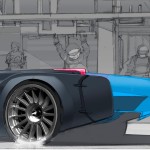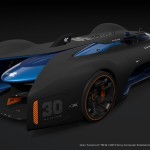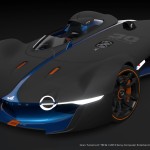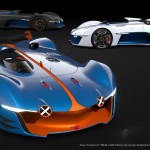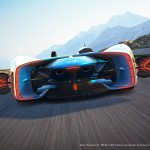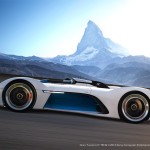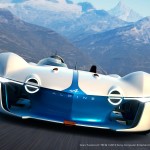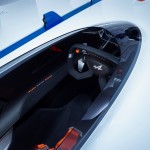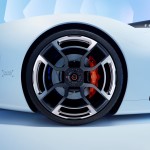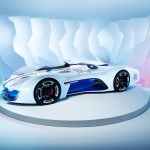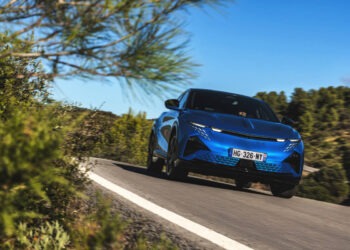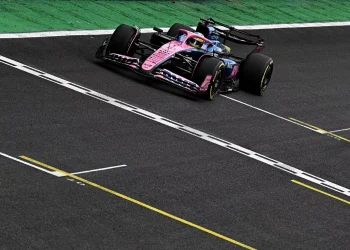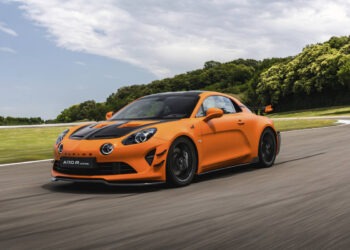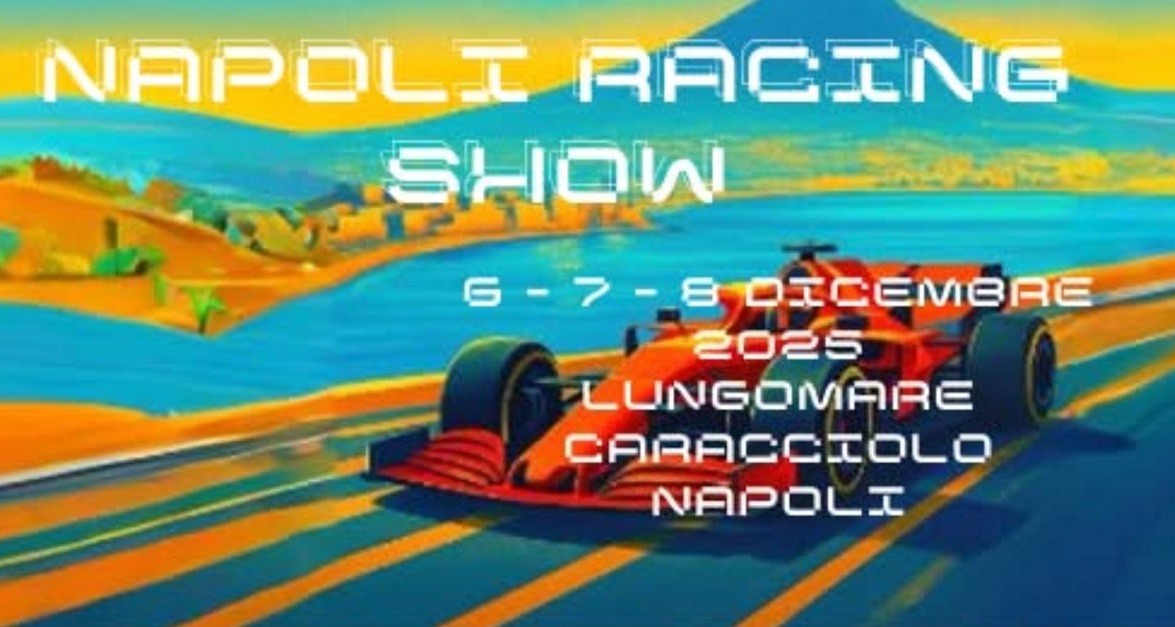The Alpine of the 21st Century is creeping gradually closer. The wait may seem interminable to the more impatient fans, but at least there is plenty going on in the meantime! In motor racing, for example, the Alpine A450 prototype collected European endurance racing titles in 2013 and 2014, as well as a podium finish in the LM P2 class in last June’s Le Mans 24 Hours.
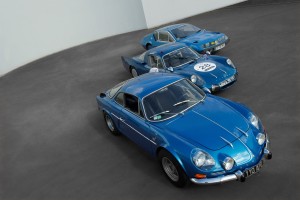 Now, as the brand’s 60th anniversary festivities get under way, the Alpine Vision Gran Turismo heralds a new chapter in the make’s revival. Polyphony Digital Inc. – developers of PlayStation®’s Gran Turismo game – proposed the challenge of creating a new ‘virtual’ car in July 2013 and the teams at Alpine turned their attention to the project with the same passion, enthusiasm and rigour as they are committing to the upcoming new road car.
Now, as the brand’s 60th anniversary festivities get under way, the Alpine Vision Gran Turismo heralds a new chapter in the make’s revival. Polyphony Digital Inc. – developers of PlayStation®’s Gran Turismo game – proposed the challenge of creating a new ‘virtual’ car in July 2013 and the teams at Alpine turned their attention to the project with the same passion, enthusiasm and rigour as they are committing to the upcoming new road car.
Bernard Ollivier, CEO, Société des Automobiles Alpine “The designers and engineers involved in this project were tasked with creating a car that expresses the spirit of our 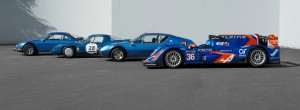 brand. Alpine’s genes are immediately visible in its styling, while its performance won’t disappoint either when players get behind the wheel, or their DualShock®PlayStation controller. They will find the same agility that helped to forge the legend of the original cars produced by Alpine founder Jean Rédélé. The Alpine Vision Gran Turismo stands at the crossroads of the past, present and future, at the frontier between motorsport and road cars. It also provides a
brand. Alpine’s genes are immediately visible in its styling, while its performance won’t disappoint either when players get behind the wheel, or their DualShock®PlayStation controller. They will find the same agility that helped to forge the legend of the original cars produced by Alpine founder Jean Rédélé. The Alpine Vision Gran Turismo stands at the crossroads of the past, present and future, at the frontier between motorsport and road cars. It also provides a  link between the virtual and real worlds. Indeed, the end result is so stunning that we couldn’t resist producing an actual full-scale model of it! The Festival Automobile International, which places the emphasis on automobile aesthetics, was seen as the ideal setting for the first ‘real life’ rendering of a car since the announcement of Alpine’s revival broke cover. It will be possible to admire our latest creation and also to enjoy it first-hand thanks to Gran Turismo®6.”
link between the virtual and real worlds. Indeed, the end result is so stunning that we couldn’t resist producing an actual full-scale model of it! The Festival Automobile International, which places the emphasis on automobile aesthetics, was seen as the ideal setting for the first ‘real life’ rendering of a car since the announcement of Alpine’s revival broke cover. It will be possible to admire our latest creation and also to enjoy it first-hand thanks to Gran Turismo®6.”
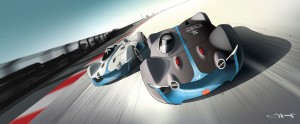 Before going into the design of the Alpine Vision Gran Turismo in more detail, it is perhaps an idea to go back more than 15 years when Sony recruited the Japanese economics student, Kazunori Yamauchi. ‘Kaz’ was an ambitious and visionary young man whose skill and passion as a game producer persuaded Sony to allow him to create his dream, five-years in the making – the ultimate driving simulator. Taking advantage of the technological breakthrough that was the PlayStation console, Polyphony Digital produced an immediate hit with the launch of Gran Turismo on 11th December, 1999. It revolutionised the video game industry with sales of the first title reaching more than 11 million copies.
Before going into the design of the Alpine Vision Gran Turismo in more detail, it is perhaps an idea to go back more than 15 years when Sony recruited the Japanese economics student, Kazunori Yamauchi. ‘Kaz’ was an ambitious and visionary young man whose skill and passion as a game producer persuaded Sony to allow him to create his dream, five-years in the making – the ultimate driving simulator. Taking advantage of the technological breakthrough that was the PlayStation console, Polyphony Digital produced an immediate hit with the launch of Gran Turismo on 11th December, 1999. It revolutionised the video game industry with sales of the first title reaching more than 11 million copies.
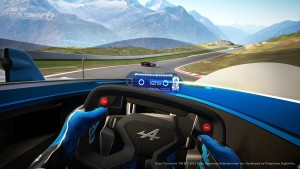 More than fifteen years later, the success story continues. Sales of the various iterations of Gran Turismo totalled more than 72 million before Gran Turismo®6 for PlayStation®3 was released in December 2014. Gran Turismo®6 stands out as a new benchmark and features over 1,200 of the world’s best cars and 39 tracks. The success of the franchise is due in great part to the partnerships its producers have sealed with the most prestigious carmakers. Grouped under the Vision Gran Turismo banner for the game’s 15th anniversary, the prototype cars that have been created especially for the occasion are eagerly awaited by car and video game enthusiasts alike.
More than fifteen years later, the success story continues. Sales of the various iterations of Gran Turismo totalled more than 72 million before Gran Turismo®6 for PlayStation®3 was released in December 2014. Gran Turismo®6 stands out as a new benchmark and features over 1,200 of the world’s best cars and 39 tracks. The success of the franchise is due in great part to the partnerships its producers have sealed with the most prestigious carmakers. Grouped under the Vision Gran Turismo banner for the game’s 15th anniversary, the prototype cars that have been created especially for the occasion are eagerly awaited by car and video game enthusiasts alike.
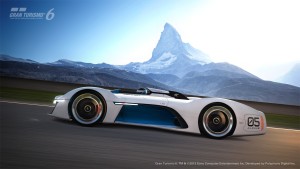 “Would you be prepared to design a car for Gran Turismo?” This simple question got the brains of the teams at Alpine thinking overtime, despite the fact that they were already busy preparing the brand’s comeback in the form of the first production car that will be presented to the public in 2016. This enticing blank sheet of paper provided them with an exciting opportunity to explore new creative ideas without having to take certain production-related constraints into account.
“Would you be prepared to design a car for Gran Turismo?” This simple question got the brains of the teams at Alpine thinking overtime, despite the fact that they were already busy preparing the brand’s comeback in the form of the first production car that will be presented to the public in 2016. This enticing blank sheet of paper provided them with an exciting opportunity to explore new creative ideas without having to take certain production-related constraints into account.
In July 2013, around 15 staff from Polyphony Digital Inc. visited Alpine’s studio where they were greeted by a similar number of people who shared the same passion for the automobile. ‘Kaz’, who has been fascinated by Alpine for some years, could not conceal his delight at the idea of hosting the French brand in his virtual showroom. Indeed, he rarely turns down a chance to indulge in a little circuit driving himself, so the inclusion of a racing marque such as Alpine held a special meaning for him.
 Very soon, the idea of a lightweight, agile, barquette-type car, in keeping with the brand’s racing programme with the A450, took form. An in-house competition involving around 15 designs was won by the project submitted by Victor Sfiazof: “It’s a genuine sportscar which combines the passion for cars with enjoyment behind the wheel. There are numerous references to the past, present and future. The idea of a barquette stemmed from the Alpine A450’s involvement in the Le Mans 24 Hours. That said, the front end takes its inspiration from the A110, while the vertical fins at the rear recall the A210 and A220 while making a real contribution to the car’s styling. As an aeronautic fan, I also wanted to incorporate cues from the world of aviation, too. The airbrakes add a nice high-tech touch to the rear end.”
Very soon, the idea of a lightweight, agile, barquette-type car, in keeping with the brand’s racing programme with the A450, took form. An in-house competition involving around 15 designs was won by the project submitted by Victor Sfiazof: “It’s a genuine sportscar which combines the passion for cars with enjoyment behind the wheel. There are numerous references to the past, present and future. The idea of a barquette stemmed from the Alpine A450’s involvement in the Le Mans 24 Hours. That said, the front end takes its inspiration from the A110, while the vertical fins at the rear recall the A210 and A220 while making a real contribution to the car’s styling. As an aeronautic fan, I also wanted to incorporate cues from the world of aviation, too. The airbrakes add a nice high-tech touch to the rear end.”
 Little by little, the car appeared in drawing form before a digital version was produced. At the same time, the chassis development engineers worked on the car’s technical characteristics. After benchmarking and comparing dozens of other cars featured in Gran Turismo, they found a set-up that put the accent on driving enjoyment, in keeping with the Alpine spirit.
Little by little, the car appeared in drawing form before a digital version was produced. At the same time, the chassis development engineers worked on the car’s technical characteristics. After benchmarking and comparing dozens of other cars featured in Gran Turismo, they found a set-up that put the accent on driving enjoyment, in keeping with the Alpine spirit.
Meanwhile, Polyphony Digital fed the data into their own software and, a little more than a year after the project’s launch, the final specification of the Alpine Vision Gran Turismo was set in concrete.
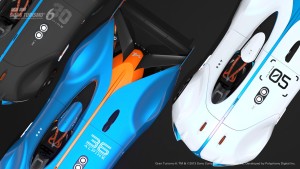 As the final icing on the cake, a new challenge was set: that of producing an actual tangible version of this incredible creation. The fruit of the model-makers’ efforts sparks a different set of sensations still, and the Alpine Vision Gran Turismo’s racy, atypical lines speak to all generations.
As the final icing on the cake, a new challenge was set: that of producing an actual tangible version of this incredible creation. The fruit of the model-makers’ efforts sparks a different set of sensations still, and the Alpine Vision Gran Turismo’s racy, atypical lines speak to all generations.
While the brief submitted to the designers was, well, brief, it included one specific stipulation in comparison with their usual creations. The key focuses of the concept car needed to be the rear end and the cockpit, simply because they are the most popular views in motor sport video games.
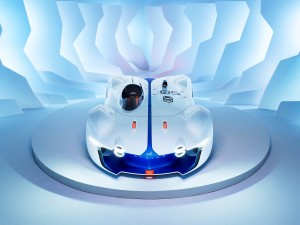 Even so, our tour begins with the front of the car, which bears a striking resemblance to the A110. The sloping V-shaped bonnet is enhanced by a central crease and, in another nod to the 1960s, the cross-shaped LED lights recall the black tape that was used to protect the additional lights fitted to the Berlinette rally cars. These references to the past blend in seamlessly with an undeniably modern aerodynamic package that includes a splitter designed to channel airflow along the body sides. It also provides a glimpse of the suspension wishbones. Openings in the bonnet expose the orange struts which are located horizontally at the top of the chassis.
Even so, our tour begins with the front of the car, which bears a striking resemblance to the A110. The sloping V-shaped bonnet is enhanced by a central crease and, in another nod to the 1960s, the cross-shaped LED lights recall the black tape that was used to protect the additional lights fitted to the Berlinette rally cars. These references to the past blend in seamlessly with an undeniably modern aerodynamic package that includes a splitter designed to channel airflow along the body sides. It also provides a glimpse of the suspension wishbones. Openings in the bonnet expose the orange struts which are located horizontally at the top of the chassis.
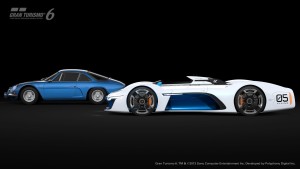 The car’s profile awakens other memories. Large air intakes direct the flow that escapes behind the front wheels and accentuate the narrow form of the body. Complementing the overall harmony, the long lateral rear fins call to mind the A210s and A220s which shone so brilliantly at Le Mans, achieving victory in the 24-hour race’s Efficiency Index class in 1966.
The car’s profile awakens other memories. Large air intakes direct the flow that escapes behind the front wheels and accentuate the narrow form of the body. Complementing the overall harmony, the long lateral rear fins call to mind the A210s and A220s which shone so brilliantly at Le Mans, achieving victory in the 24-hour race’s Efficiency Index class in 1966.
The wheels alone are eloquent of the fusion of present and past. The design of the rims – inspired by those fitted to the A110s – is sufficiently open to reveal the impressive brake callipers, painted in orange or blue, depending on the version.
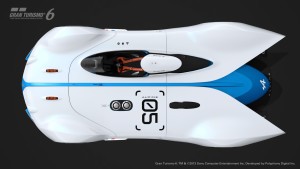 The appeal of the Alpine Vision Gran Turismo is further enhanced by its open cockpit. The driver sits on the right, a design typical of sport-prototype cars given that the majority of circuits – not least of which Le Mans – run in a clockwise direction.
The appeal of the Alpine Vision Gran Turismo is further enhanced by its open cockpit. The driver sits on the right, a design typical of sport-prototype cars given that the majority of circuits – not least of which Le Mans – run in a clockwise direction.
The roll cage is stylishly integrated, as is the engine air intake duct on the left-hand side. A butterfly door facilitates access, enabling the driver to slide on board. When it opens, it is possible to glimpse a little more of the work that has been carried out. The visible stitching of the leather seat is redolent of the famous cross pattern, complete with blue thread that brings a modern feel. The almost rectangular steering wheel, of the sort seen on the endurance racing prototypes, is crowned by digital instruments. Indispensable in fast-and-frenetic races, the rear view mirrors have been replaced by a high-definition camera.
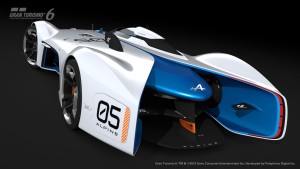 The rear-end design represents an unmistakeable highlight of the Alpine Vision Gran Turismo. The flat bottom that runs beneath the car terminates in arched form, while a lower wing links the wheel arches to the stern. As at the front, the bodywork exposes the double wishbone suspension. A second, beautifully integrated wing yields even more aerodynamic downforce.
The rear-end design represents an unmistakeable highlight of the Alpine Vision Gran Turismo. The flat bottom that runs beneath the car terminates in arched form, while a lower wing links the wheel arches to the stern. As at the front, the bodywork exposes the double wishbone suspension. A second, beautifully integrated wing yields even more aerodynamic downforce.
The most striking characteristics of the Alpine Vision Gran Turismo become apparent under braking. Integrated into the profile of the tail, the hydraulically-activated airbrakes can be deployed in an instant, while at the same time revealing the brake lights!
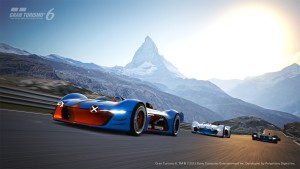 Gran Turismo allows players to choose between three personalised colours:
Gran Turismo allows players to choose between three personalised colours:
- White and blue: this elegant, understated livery is also the colour scheme chosen for the full-scale model of the car
- Orange and blue: inspired by the Alpine A450, two-time European Endurance Champion
- Matt black: in true gamer style
The Alpine Vision Gran Turismo will be seen for the first time at this year’s Festival Automobile International in Paris, France. For 30 years, this yearly gathering of experts in the fields of aesthetics and automotive excellence 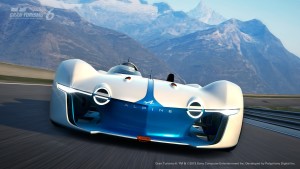 has presented a number of special awards, including one for the Plus Belle Voiture de l’Année (Most Beautiful Car of the Year). After its unveiling during the gala evening at the French capital’s Hôtel des Invalides on Tuesday, 27th January, the car will remain on display at the Festival until 1st February.
has presented a number of special awards, including one for the Plus Belle Voiture de l’Année (Most Beautiful Car of the Year). After its unveiling during the gala evening at the French capital’s Hôtel des Invalides on Tuesday, 27th January, the car will remain on display at the Festival until 1st February.
After that, it will be exhibited at the 2015 Rétromobile Show (4-8th February) at the Porte de Versailles, Paris, where celebrations of Alpine’s 60th anniversary will kick off in earnest.
The Alpine Vision Gran Turismo will be made available as part of a free update of Gran Turismo®6 for PlayStation®3 in March 2015. To discover the car, players will select ‘Vision GT’ on the ‘My Home’ page. After choosing the body colour, you will be able to admire your acquisition in full-screen mode, along with a detailed description. It will also be possible to view videos and sketches starring the Alpine Vision Gran Turismo before you take part in your first race…










